Time is the cruelest kindness.
Welcome to my first rant, and the rebirth of Rooftop Confessions. Luckily, that particular mistake of youth was erased forever, but the lessons learned will never be forgotten.
Today, I’d like to discuss one of the foundations of modern anime, the character archetype known as the “tsundere” (ツンデレ). Its etymology stems from the words tsuntsun, meaning prickly or abrasive towards others, and deredere, meaning mushy or loving. As I’m sure you know, when put together they describe a character (often female) who is at times harsh to the one they love, and at others bashful, submissive and loving. The tsundere is a staple of the harem genre, and there are often many types within a single series. When localized, it often becomes “bipolar”, “sweet and sour”, or “hot and cold”, among other such nonsense, but those fail to truly capture the meaning of the word.
So why the quote? If you’ve been watching anime for long enough then I’m sure you understand my anguish at the changing meaning of words over time. In the original lexicon, a tsundere was defined as a girl who really does dislike the protagonist. She may abuse him physically or verbally, and she may have good reasons or not, but in the end, she drives most others away with her spiky exterior. But love and hate are two sides of the same coin. As the foolish protagonist continues trying to get close to her, our little tsundere slowly develops feelings for him and starts to open up. It is at this point that she may utter that legendary line, “I-It’s not like I made this for you or anything, so don’t misunderstand!” and make our hearts overflow with moe. Much like the chestnut, it is a reward that comes only after much toil, and that makes it all the sweeter. Although there may be slight relapses out of embarrassment, a permanent, positive change in the tsundere has occurred. Ideal tsundere of this type include Narusegawa Naru (Love Hina) and Louise Françoise (Zero no Tsukaima, first season).
But as time is wont to do, it started to erode those things we had the most trust in. The ever-so-vital time aspect of the tsundere became shorter and shorter, until the day came when the coin deformed enough for both sides to be seen simultaneously. Now we have characters who flip back and forth at the drop of a hat. Instead of a nicely toasted marshmallow, all we’re getting is sugar on fire. It has become such a joke that most parody anime have at least one meta-gag about it. For a small selection of choice examples, see Shinonome Houki (Infinite Stratos) and Fuyuumi Ai (OreShura).
Is the tsundere dead? Of course not. As I said at the very beginning, though the passage of time may be cruel, within it is a warmly glowing kindness. Neo-tsundere are not inherently bad, and they have even paved the way for some extremely unique characters like Senjougahara Hitagi (Bakemonogatari) and Inaba Himeko (Kokoro Connect). Times will continue to change; who knows what the next winds will blow in.
I would’ve like to end at such a good point, but any good tsundere explanation can’t go without the mention of the Queen of Tsundere, Kugimiya Rie. Known for her very similar roles such as Shana, Louise, Nagi, and Taiga (among others), her voice truly is the epitome of tsundere. And yet, despite their similarities, within each character is a unique element, and her ability is such that those with a trained ear can pick out who she is voicing without reference. But talk of seiyuu should be left for yet another time, another place. Let’s meet again, at the next Rooftop Confessions.


This! I miss the old tsundere though Shana an Louise still my 2nd and 3rd of my top 10 respectively I doubt any new character will be able to replace those 2 in my heart though.
About neo-tsudnere I agree they are not all bad but some of them are really annoying since they keep changing mood so often that it makes unlikely to like them.
First time coming across the term “neo-tsundere”. Do you mind explaining what that is exactly?
It’s explained on the text already so just read it but in summary real tsundere are the original ones that gave origin to the term and the new ones (neo-tsundere) are just bipolar instead of changing over time.
Well, as I read, the specific term “neo-tsundere” isn’t actually explained. I’m guessing (from what you say) neo-tsundere is just a tsundere that is neo (new tsundere). I would disagree to Senjougahara being a tsundere though as she is not very dere-dere. However, I concede the point that “neo-tsundere has paved the way some extremely unique characters” such as Senjougahara. It isn’t to say that she is a neo-tsundere. It’s just that the neo-tsundere “archtype” lead to the character that is Senjougahara who may be described using a different kind of archtype.
Yeah, you can call tsundere the old ones like Victorique, Taiga, Louise those that initially hate the protagonist but become caring and kind with the passing of time so in summary the very origin of the term and neo-tsundere the new ones that are just bipolar changing mood all the time for no reason like Fuyumi Ai (personally I dislike her) and all those new tsundere that don’t follow the original ones.
I personally miss this kind of character since since neo-tsundere is very common now a days, it’s not like I hate the new ones though it’s just that they don’t have the same feel and some of them are even too annoying.
The old-school vs neo-tsundere debate is pretty interesting. Personally I have grown somewhat attached to neo-tsundere personalities, even though they can be obnoxious at times. I actually wrote a blog post about this a few weeks ago if you’reinterested 😀
http://deredeck.com/blog/discussion/tsundere-vs-neo-tsundere-which-is-the-real-tsunderekko/
so, the neo-tsundere is the intellectual tsundere?